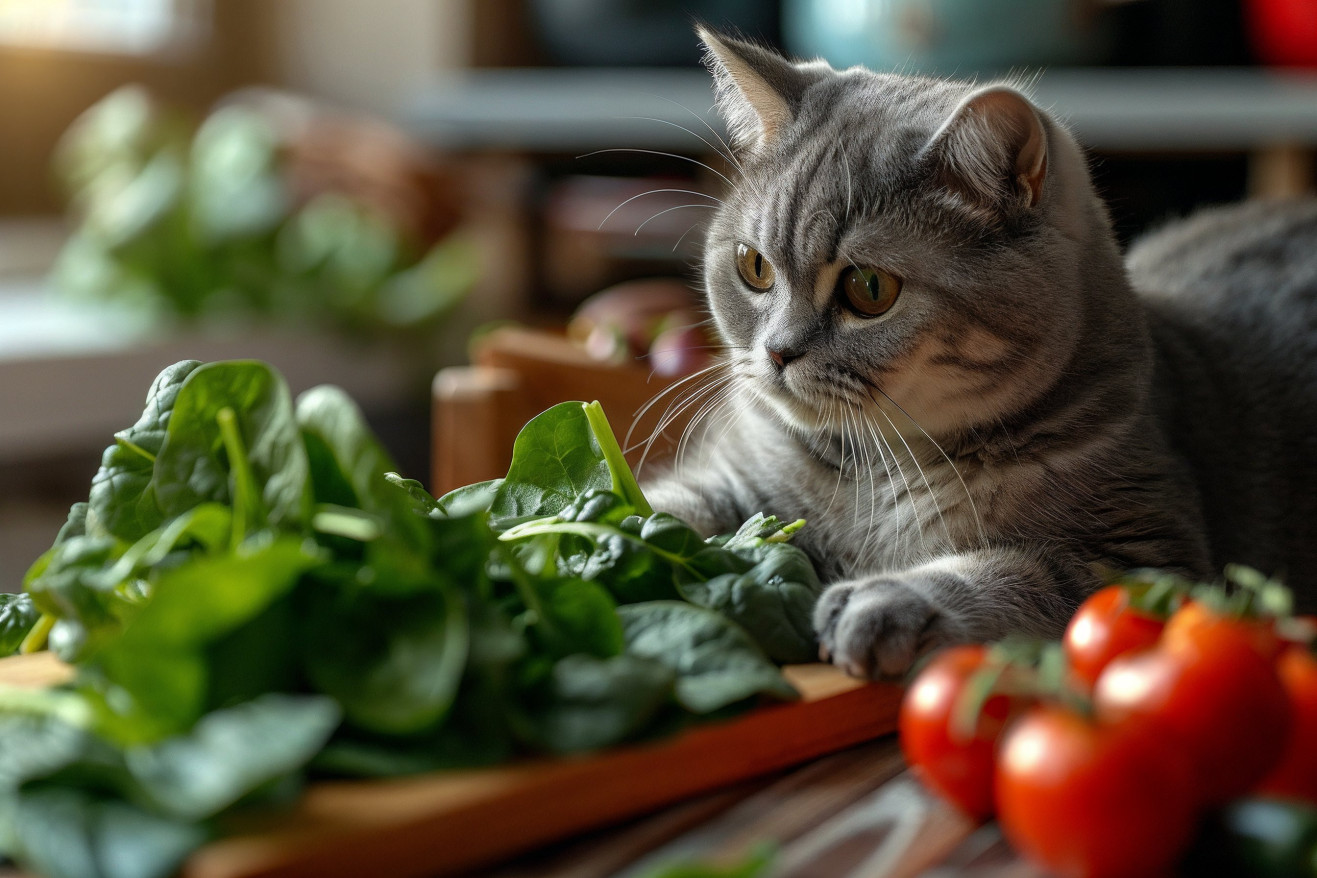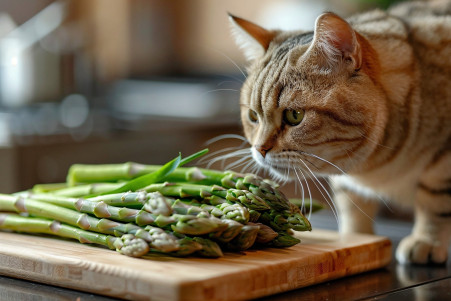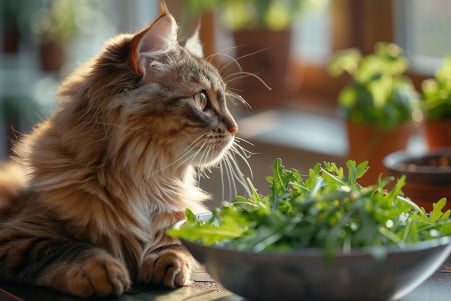Can Cats Eat Spinach? The Benefits and Risks
11 February 2024 • Updated 10 February 2024

Although spinach is often considered a superfood for humans, it’s a little more complicated when it comes to cats. Cats can eat spinach in moderation because it’s not toxic and it contains important nutrients like vitamins A and K.
However, spinach should be fed in moderation because of its calcium oxalate content, especially for cats with urinary tract issues. As always, it’s important to talk to your vet before adding new foods to your cat’s diet.
This article takes a deep dive into the nutritional nuances of a cat’s diet, drawing on veterinary expertise and nutritional research. This includes looking at what a cat’s diet needs to include, how oxalates can impact a cat’s health, and the bigger picture of feeding plant-based foods like spinach to obligate carnivores.
By bringing these insights together, this article aims to offer a thorough understanding that will help you make the best choices when it comes to feeding your cat plant-based foods like spinach.
Can cats eat spinach?
Spinach: Nutritional Information for Cats
Your cat can take advantage of the many nutrients found in spinach. According to Catological, spinach contains vitamins A, K, B6, B2, E, C, magnesium, folate, calcium, and potassium. These vitamins and minerals can help with everything from skin and eye health to the immune system and muscle function. In addition, the fiber in spinach can help with digestion and prevent constipation.
If you want to give spinach to your cat as a treat, Modern Vet suggests giving them small amounts of cooked spinach, which has a lower oxalate content than raw spinach and is easier on the stomach. However, Hepper warns that if your cat has a history of calcium oxalate bladder stones, you should avoid giving them spinach to prevent making the condition worse.
While spinach can be a good source of nutrition, it’s not necessary for a cat’s diet and should be given in moderation. If you’re looking for other vegetables to give your cat, cucumbers are safe and can also help with hydration due to their high water content. Just remember that a cat’s primary source of nutrition should come from a high-quality, meat-based diet, with vegetables like spinach playing a secondary role.
Feline Nutrition: What Cats Need in Their Carnivorous Diet
According to the Cornell University College of Veterinary Medicine, cats are obligate carnivores, which means they require nutrients that are only found in animal tissues to survive. Their diet needs to be high in protein because proteins are the building blocks of growth, maintenance, and repair. VCA Animal Hospitals explains that cats need to get essential amino acids, such as taurine, from animal sources because they can’t make them from plant sources.
While vegetables like spinach are not necessary in a cat’s diet and are not something cats would eat in the wild, they can be okay as long as they are added in a way that makes sense for the cat’s diet and are given in moderation. Straying from a diet that is mostly made up of meat can lead to deficiencies and other health issues, which shows the importance of sticking to species-appropriate feeding.
The primary nutritional needs of cats are best met by high-quality commercial cat foods, which are designed to meet the specific needs of cats, according to the Association of American Feed Control Officials.
This means that when it comes to supplemental treats like spinach, it’s important to make sure that these nutritional needs are still being met and that the treats are truly supplemental and not making up a large part of the cat’s diet. This way, the cat’s health is supported and it’s possible to consider the benefits of specific vegetables like spinach.
Oxalates: A Risk Factor in Feline Nutrition
Many plants, including spinach, contain oxalates, which are organic compounds that can bind with calcium to create calcium oxalate crystals. While these crystals aren’t harmful by themselves, they can pose a problem for cats, especially in terms of urinary tract health. Cats that eat high-oxalate foods like spinach can develop calcium oxalate urolithiasis, which is the formation of stone-like deposits in the urinary tract.
According to a study published in PubMed by Dijcker, cats have relatively low exogenous sources of urinary oxalates, but the role of dietary oxalates is not completely understood. This is something that cat owners should be aware of, especially since the prevalence of calcium oxalate stones in cats is on the rise, according to VIN. Certain breeds are especially at risk, including Burmese, Himalayan, and Persian cats, according to a study by Bartges.
If your cat has a history of urinary tract issues, you should be careful about the amount of oxalates in their diet. Signs that your cat may be sensitive to oxalates include frequent urination, straining to urinate, and blood in the urine.
If you notice any of these signs, it’s important to talk to your vet, who can offer advice based on your cat’s individual health and dietary needs. Being a responsible pet owner means understanding these risks and making dietary choices that are best for your cat’s health.
A Little Crunchy: Adding Vegetables to Your Cat’s Diet
While cats are obligate carnivores, there are some vegetables that can add some extra nutrients and variety to their diet. According to BeChewy, vegetables like carrots, peas, and green beans can add vitamins and fiber to your cat’s diet that can be beneficial.
However, these vegetables should be given in moderation since they don’t have the high protein and fat content that cats need. In fact, Preventive Vet notes that cooking vegetables like spinach can make them more digestible for cats.
When you first add vegetables to your cat’s diet, start with small amounts to see how your cat reacts. You can also purée or mash vegetables to make them more appealing and easier for your cat to eat. Feline Wellness notes that adding safe vegetables like zucchini and broccoli to your cat’s diet can help ensure that your cat gets a well-rounded diet.
Remember, it’s important to add variety to your cat’s diet to keep them from getting bored and to make sure they get all the nutrients they need. However, it’s also important to talk to your vet before making any major changes to your cat’s diet to make sure you’re meeting their specific health needs and maintaining the balance of their carnivorous diet.
Final Thoughts: Spinach as a Part of a Cat’s Balanced Diet
In summary, when given in moderation, spinach can be a healthy addition to a cat’s diet because it contains several vitamins and minerals, including vitamins A, K, B6, B2, and E, magnesium, folate, calcium, and potassium, according to Purina. That said, it’s not necessary for a cat’s diet, and cats with kidney or urinary issues should be careful when eating spinach because it contains calcium oxalate, which can contribute to urinary tract problems.
The bottom line is that cats are obligate carnivores, and their diet should reflect that by prioritizing animal-based proteins and essential amino acids. Vegetables, including spinach, are secondary and should not take away from the protein-based diet that cats need.
If you’re thinking about adding spinach to your cat’s diet, even if it’s just an occasional treat, it’s important to talk to your vet, especially if your cat has a history of urinary tract issues.
This will help ensure that any dietary changes are in line with your cat’s specific health concerns, highlighting the importance of a well-rounded diet that’s tailored to your pet.
As we’ve looked at leafy greens and the specifics of what cats need in their diet, it’s important to remember the importance of balance and working with a professional to make sure we’re taking care of our feline friends.


